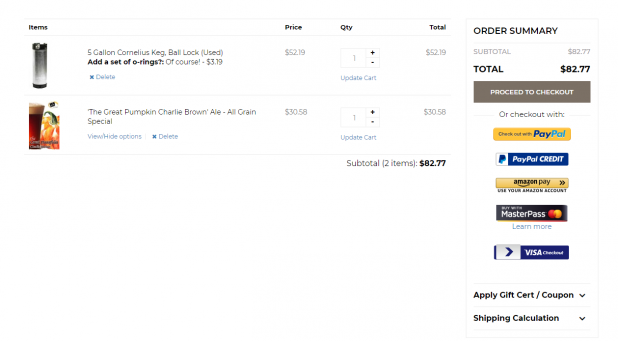When it comes to eCommerce, you have an abundance of choices. Between design decisions, shopping cart platforms, web hosting, and everything else that goes into creating an online store, you have a vast menu of options from which you can build your eCommerce presence.
An unfortunate side effect of this abundance is that it verges on overabundance. Even established eCommerce businesses are often faced with what feels like too many choices, and with over 100 shopping cart platforms on the market, even the relatively early decision of which software to use can be overwhelming — especially when you learn about the limitations of certain platforms and become aware that your choice might come back to bite you later. What works now might hinder you in the future.
In a world of differing budgets, unique value propositions, business sizes, growth rates, and other variables, you can’t make an informed decision by following the crowd. Your decisions need to be based solely on the needs and capabilities of your business.
Here are the five most important things you need to know to make an informed choice as to the eCommerce platform you use to create your website.
1. Know how much you can spend
Intimate knowledge of your budget is crucial to every business decision you make. Your eCommerce website is no different. You need to understand how much you can spend to get your online store off the ground and how much you can afford every month to keep it running.
Having a solid number to work from can help you narrow down your choices significantly.
If you start looking at eCommerce platform pricing before you have a budget in mind, you can come away with a distorted view of what your online store might actually cost you.
The smarter thing to do is to identify your website budget and go from there, rather than trying to bargain-hunt without understanding what you’ll be getting for your money. This ties directly into the next point on this list.
2. Understand the implications of free software
Resist the temptation to immediately choose a free shopping cart solution. Too many business owners think they’re beating the system by using free software, but what they’re really doing is shifting the cost elsewhere.
The fact is that nothing is free and there are always costs. Even if the software you use doesn’t have a price tag, you’ll still have to pay for web hosting, and probably for development and support. Free software can end up costing a business more than a paid platform, and in a less predictable (and therefore, harder to budget for) manner.
We’re not saying a free platform can’t be the right solution in some cases, but eCommerce entrepreneurs who jump blindly into them are often stifling their own growth or setting themselves up for larger expenses later. The key is that there’s a tradeoff between free software and paid software: paid platforms often function as an all-in-one solution that includes web hosting, site security, software upgrades and support, and other essentials.
That monthly fee actually covers quite a few things you’d otherwise need to handle on your own if using a free platform. If you’re working under budget or staffing restrictions, you’re actually more likely to benefit from a paid solution.
3. Know what it takes to handle your inventory
Start with a straightforward product count. How many different items do you sell? Some eCommerce platforms restrict the number of products you can add to your store, so it’s helpful to know if you’ll be harmed by such a limit.
Next, look at the types of products you sell. You want your online store to show them off to their best advantage, so what kinds of features would be needed to accomplish that? Different types of products are going to have different needs. For example, if you sell ebooks via digital download, you’re probably not going to need photo galleries of high-quality images. But if you sell jewelry, apparel, or any other type of highly-detailed product, image galleries are practically required. Customers will want to see the intricacies of the materials and workmanship that go into your products.
Third, do your products have options or variants, such as size and color? If so, figure out how many variants there are and how many variant combinations can be made. Some eCommerce platforms limit how many variants a single product can have, forcing you to create a duplicate product to handle the overflow.
4. Know your target market’s preferred payment methods
Different customer demographics prefer different methods of payment. Millennials in the tech industry prefer things like digital wallets and cryptocurrency. On the other end of the spectrum, there are still senior citizens out there who want to order by phone and pay by mailing a check.
Throughout the middle of these extremes, you have people who prefer credit cards, others who want to pay with their existing Amazon or Google account, diehard PayPal fans, and more.
The better you understand your customer base, the more likely you’ll be to know how they’d prefer to pay for their purchases. You can learn directly from customer feedback as well as through research. Ultimately, though, this knowledge is pointless unless you use an eCommerce platform that actually lets you accept the payment methods your customers want to use.
Before you choose a platform, look at their integrated payment processors. Anything tightly limited is bound to hold you back from future expansion.
5. Consider your company’s growth
You’d be surprised how many small businesses think small. It’s not that they don’t want to grow, it’s more that they don’t consider how they’ll function once they’ve grown — or how the technology they rely on will handle larger numbers of customers and products.
The eCommerce platform you choose should meet two growth criteria. First, it must be scalable to grow with your business, otherwise you’ll have to switch platforms later. That will cost time, money, and possibly sales if your website needs to go offline during the changeover.
Second, your platform must have an infrastructure powerful enough to handle unexpected surges in traffic. Some traffic surges are a bit predictable — maybe you’ve invested in some highly-targeted marketing likely to attract a large number of customers, or maybe the holidays are approaching and you’re selling a hot product.
But sometimes you can get huge amounts of traffic when you least expect it. If your online store is linked on a popular website, you can experience a huge influx of visitors that can overload your site and cause it to go down. Sites like Slashdot, Digg, Reddit, and others have all caused this, leading to terms like the “Slashdot effect” or as Reddit users call it, the “hug of death” — the implication being that the website has collapsed under its own sudden popularity!
The last thing you want is for your online store to go offline during a time like this, because you’ll lose out on all the sales you could make to these new visitors.
Conclusion
Hopefully, you’ll leave this article feeling a bit more informed about what to look for when you’re choosing an eCommerce platform, and why your choices matter. You’ll still have a process ahead of you, in which you compare and contrast the features and benefits of each solution that interests you. But now, you’ll have an idea of which should be taken off the table immediately.
Ultimately, the decision rests with you and with the needs of your business. Keep your specific requirements in mind and watch out for hidden costs, and you’ll be sure to arrive at a platform that will serve your business well.






